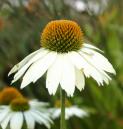The seeds and herb of Sisymbrium officinale, Scopoli (Erysimum officinale, Linné).
Nat. Ord.—Cruciferae.
COMMON NAME: Hedge mustard.
Botanical Origin.—This is an annual, herbaceous plant, with a round, more or less hairy, branching stem, from 1 to 3 feet high. The leaves are runcinate; the lower ones 3 to 8 inches long by 1 to 3 wide, the lower segments placed at right angles to the midvein, or pointing backward, and the terminal segment largest; the upper ones in 3 lanceolate segments placed at right angles. The flowers are small, yellow, and terminate the slender, virgate raceme, which becomes 1 or 2 feet long. Siliques or pods subulate, erect, sessile, and closely appressed to the rachis. Seeds in a single row in each cell, ovoid, and marginless (W.—G.).
History and Chemical Composition.—This is an unsightly weed, inhabiting the United States and Europe, growing in waste places, and flowering from May to September. Its taste is herb-like, faintly resembling that of mustard. The seeds, leaves, and flowering tops are used; the former possess the greatest pungency and yield oil of mustard (Pless). Water extracts its active properties by infusion.
Action, Medical Uses, and Dosage.—Hedge mustard is reputed expectorant, and has been used with advantage in hoarseness, old coughs, asthma and ulcerated throat; likewise said to exert some influence as a diuretic in urinary obstructions. The powdered seeds may be used internally in the dose of from 5 to 30 grains, or an infusion may be given every 2 or 3 hours in tablespoonful doses. The juice rubbed up with sugar or honey is also used.
Related Species.—Sisymbrium sophia, or Flax weed, with bipinnately-divided leaves, the lobes oblong-linear, incised; pedicels four times the length of the calyx; petals smaller than the sepals; is a very intensely pungent plant. Its seeds have been recommended in gravel, and to remove worms; and a fomentation of the leaves as an application to obstinate ulcers.
Sisymbrium muralis (Diplotaxis muralis) has been employed by the French alone or in a syrup, with potassium iodide, as a remedy for blood dyscrasia, especially in scorbutic and scrofulous affections.
Sisymbrium Alliaria, Scopoli (Erysimum Alliaria, Linné; Alliaria officinalis, Andrew), or Hedge garlic, contains a bitter body and volatile oil, consisting of oil of mustard (90 per cent.) and oil of garlic (10 per cent) it imparts to the plant an alliaceous odor (Pless, 1846).

